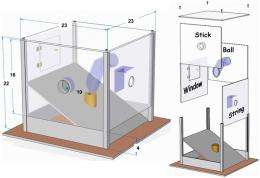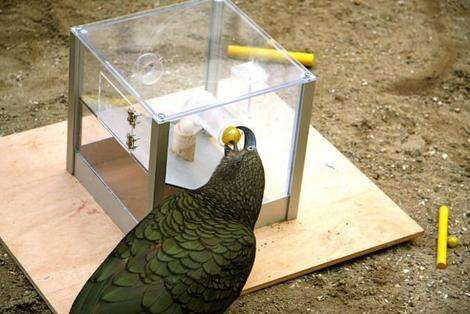June 9, 2011 report
New study of crows and parrots highlights different types of intelligence

(PhysOrg.com) -- In an experiment designed to illustrate the different ways that animals use their own unique type of intelligence to accomplish certain goals, a team of zoologists and biologists from the University of Vienna and Oxford University, led by biologist Dr. Alice Auersperg have shown that New Caledonian crows and a type of green parrot called the kea, are both able to accomplish similar difficult tasks, but go about doing so in very different ways. In a paper published in PLoS ONE, the team describe how when confronted with a box with food inside, both species of birds showed high levels of intelligence in getting at that food, but went about doing so in ways uniquely suited to their physical and behavioral attributes.
The box was constructed of clear see-through plastic and had four walls, each of which had a means of allowing access to a bit of food mounted on a pedestal in the center of the box. The first method, and the one that all the birds tested found the easiest, was a string protruding from a wall that was tied to the food; pulling on it resulted in the food being yanked off its platform and rolling downhill and out of the box. The next wall consisted of a hole with a tube leading downhill to the food; pushing a marble through the hole caused it to roll downhill knocking off the food. The next wall consisted of nothing but a hole in the wall, which meant to get the food treat, the birds had to shove a wooden rod through the hole to knock it off its pedestal. And lastly, the fourth wall had a window that could be opened outward by use of a hook, thus allowing access to the inside of the box and the treat.
In the video that accompanies the paper, it’s easy to see the differences in the bird’s makeup; the crows are careful and appear worried about being seen while working to get at the food, while the keas throw caution to the wind and attack the box with abandon, resorting to using the tools and such only when they find they can’t simply knock the box apart or turn it over. In some respects, it’s sort of like watching the difference between cats and dogs. Cats slowly stalk their prey, sneaking up on it and catching it by surprise, whereas dogs bound in, all engines firing, hoping to outrun or outlast whatever it’s trying to catch.

But the experiment shows more than that as well; it permanently puts to rest the idea that we human beings exist on some sort of higher plane; in watching the birds work through the puzzle of trying to gain access to the food, you can see them thinking; especially the poor kea, when it finds it must push a small rod through a hole to get it’s reward. It’s beak was never meant for such a task, so, he resorts to using both beak and claws to work the rod until finally figuring out a way to push it through the hole and then to shove it at the food. You can’t help but wonder how some of us human beings would have done under similar circumstances.
More information: Auersperg AMI, von Bayern AMP, Gajdon GK, Huber L, Kacelnik A (2011) Flexibility in Problem Solving and Tool Use of Kea and New Caledonian Crows in a Multi Access Box Paradigm. PLoS ONE 6(6): e20231. doi:10.1371/journal.pone.0020231
Abstract
Parrots and corvids show outstanding innovative and flexible behaviour. In particular, kea and New Caledonian crows are often singled out as being exceptionally sophisticated in physical cognition, so that comparing them in this respect is particularly interesting. However, comparing cognitive mechanisms among species requires consideration of non-cognitive behavioural propensities and morphological characteristics evolved from different ancestry and adapted to fit different ecological niches. We used a novel experimental approach based on a Multi-Access-Box (MAB). Food could be extracted by four different techniques, two of them involving tools. Initially all four options were available to the subjects. Once they reached criterion for mastering one option, this task was blocked, until the subjects became proficient in another solution. The exploratory behaviour differed considerably. Only one (of six) kea and one (of five) NCC mastered all four options, including a first report of innovative stick tool use in kea. The crows were more efficient in using the stick tool, the kea the ball tool. The kea were haptically more explorative than the NCC, discovered two or three solutions within the first ten trials (against a mean of 0.75 discoveries by the crows) and switched more quickly to new solutions when the previous one was blocked. Differences in exploration technique, neophobia and object manipulation are likely to explain differential performance across the set of tasks. Our study further underlines the need to use a diversity of tasks when comparing cognitive traits between members of different species. Extension of a similar method to other taxa could help developing a comparative cognition research program.
© 2010 PhysOrg.com




















